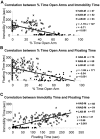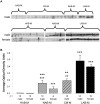Identification of glyoxalase-I as a protein marker in a mouse model of extremes in trait anxiety
- PMID: 15858064
- PMCID: PMC6725100
- DOI: 10.1523/JNEUROSCI.0115-05.2005
Identification of glyoxalase-I as a protein marker in a mouse model of extremes in trait anxiety
Abstract
For >15 generations, CD1 mice have been selectively and bidirectionally bred for either high-anxiety-related behavior (HAB-M) or low-anxiety-related behavior (LAB-M) on the elevated plus-maze. Independent of gender, HAB-M were more anxious than LAB-M animals in a variety of additional tests, including those reflecting risk assessment behaviors and ultrasound vocalization, with unselected CD1 "normal" control (NAB-M) and cross-mated (CM-M) mice displaying intermediate behavioral scores in most cases. Furthermore, in both the forced-swim and tail-suspension tests, LAB-M animals showed lower scores of immobility than did HAB-M and NAB-M animals, indicative of a reduced depression-like behavior. Using proteomic and microarray analyses, glyoxalase-I was identified as a protein marker, which is consistently expressed to a higher extent in LAB-M than in HAB-M mice in several brain areas. The same phenotype-dependent difference was found in red blood cells with NAB-M and CM-M animals showing intermediate expression profiles of glyoxalase-I. Additional studies will examine whether glyoxalase-I has an impact beyond that of a biomarker to predict the genetic predisposition to anxiety- and depression-like behavior.
Figures










Similar articles
-
Candidate genes of anxiety-related behavior in HAB/LAB rats and mice: focus on vasopressin and glyoxalase-I.Neurosci Biobehav Rev. 2007;31(1):89-102. doi: 10.1016/j.neubiorev.2006.07.003. Epub 2006 Aug 28. Neurosci Biobehav Rev. 2007. PMID: 16934871 Review.
-
Protein biomarkers in a mouse model of extremes in trait anxiety.Mol Cell Proteomics. 2006 Oct;5(10):1914-20. doi: 10.1074/mcp.M600088-MCP200. Epub 2006 Jun 14. Mol Cell Proteomics. 2006. PMID: 16775081
-
Cross-fostering and cross-breeding of HAB and LAB rats: a genetic rat model of anxiety.Behav Genet. 2001 Jul;31(4):371-82. doi: 10.1023/a:1012222402346. Behav Genet. 2001. PMID: 11720123
-
Increased levels of conditioned fear and avoidance behavior coincide with changes in phosphorylation of the protein kinase B (AKT) within the amygdala in a mouse model of extremes in trait anxiety.Neurobiol Learn Mem. 2012 Jul;98(1):56-65. doi: 10.1016/j.nlm.2012.04.009. Epub 2012 May 9. Neurobiol Learn Mem. 2012. PMID: 22579802
-
Altered glyoxalase 1 expression in psychiatric disorders: cause or consequence?Semin Cell Dev Biol. 2011 May;22(3):302-8. doi: 10.1016/j.semcdb.2011.02.005. Epub 2011 Feb 17. Semin Cell Dev Biol. 2011. PMID: 21315168 Review.
Cited by
-
Association of oxidative stress to the genesis of anxiety: implications for possible therapeutic interventions.Curr Neuropharmacol. 2014 Mar;12(2):120-39. doi: 10.2174/1570159X11666131120232135. Curr Neuropharmacol. 2014. PMID: 24669207 Free PMC article.
-
Differential stress-induced neuronal activation patterns in mouse lines selectively bred for high, normal or low anxiety.PLoS One. 2009;4(4):e5346. doi: 10.1371/journal.pone.0005346. Epub 2009 Apr 28. PLoS One. 2009. PMID: 19399175 Free PMC article.
-
Real-time imaging of amygdalar network dynamics in vitro reveals a neurophysiological link to behavior in a mouse model of extremes in trait anxiety.J Neurosci. 2013 Oct 9;33(41):16262-7. doi: 10.1523/JNEUROSCI.2397-13.2013. J Neurosci. 2013. PMID: 24107957 Free PMC article.
-
A high-salt diet further impairs age-associated declines in cognitive, behavioral, and cardiovascular functions in male Fischer brown Norway rats.J Nutr. 2013 Sep;143(9):1406-13. doi: 10.3945/jn.113.177980. Epub 2013 Jul 17. J Nutr. 2013. PMID: 23864508 Free PMC article.
-
Increased conditioned place preference for cocaine in high anxiety related behavior (HAB) mice is associated with an increased activation in the accumbens corridor.Front Behav Neurosci. 2014 Dec 22;8:441. doi: 10.3389/fnbeh.2014.00441. eCollection 2014. Front Behav Neurosci. 2014. PMID: 25566008 Free PMC article.
References
-
- Bai F, Li X, Clay M, Lindstrom T, Skolnick P (2001) Intra- and interstrain differences in models of “behavioral despair.” Pharmacol Biochem Behav 70: 187-192. - PubMed
-
- Benton D, Nastiti K (1988) The influence of psychotropic drugs on the ultrasonic calling of mouse pups. Psychopharmacology (Berl) 95: 99-102. - PubMed
-
- Branchi I, Santucci D, Puopolo M, Alleva E (2004) Neonatal behaviors associated with ultrasonic vocalizations in mice (mus musculus): a slowmotion analysis. Dev Psychobiol 44: 37-44. - PubMed
-
- Brunelli SA, Vinocur DD, Soo-Hoo D, Hofer MA (1997) Five generations of selective breeding for ultrasonic vocalization (USV) responses in N:NIH strain rats. Dev Psychobiol 31: 255-265. - PubMed
-
- Brush FR (2003) The Syracuse strains, selectively bred for differences in active avoidance learning, may be models of genetic differences in trait and state anxiety. Stress 6: 77-85. - PubMed
Publication types
MeSH terms
Substances
LinkOut - more resources
Full Text Sources
Medical
Molecular Biology Databases
Miscellaneous
